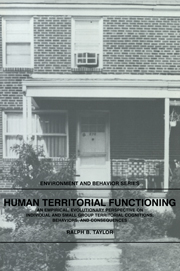 Human Territorial Functioning
Human Territorial Functioning Published online by Cambridge University Press: 05 February 2010
Streets, boundaries, forecourts, and entrances are key areas for self-expression. All those who enter a house must pass through some forecourt. Creating a good impression, a powerful impression, or a friendly, welcoming one depends very much on this “front.” This area is also very susceptible to pressure from neighbors. A resident who fails to mow the lawn regularly or to paint the house, or who leaves old cars outside will soon incur the ire of neighbors in most communities. It may be property values that people worry about or it may be simply the sense of street identity.
– Don Appleyard, “Home” (1979)The conceptual framework introduced in the preceding chapter associated human territorial functioning with four classes of consequences: social psychological within group, social psychological between group, psychological, and ecological. That framework is more fully specified in the current chapter.
Organization of the chapter
Two additional perspectives are introduced that clarify how the psychological and ecological consequences of territorial functioning, depicted in the preceding chapter, emerge. A context-specific stress model developed by Dan Stokols is outlined. This perspective delineates the process leading to stress-related consequences. It is particularly helpful in considering spaces where the person-place bonds are of high centrality. In relatively private locations, where the person-place bond is of high centrality, territorial functioning accomplishes a spatiotemporal sorting, reducing conflicting functional demands and thereby decreasing experienced stress.
To save this book to your Kindle, first ensure [email protected] is added to your Approved Personal Document E-mail List under your Personal Document Settings on the Manage Your Content and Devices page of your Amazon account. Then enter the ‘name’ part of your Kindle email address below. Find out more about saving to your Kindle.
Note you can select to save to either the @free.kindle.com or @kindle.com variations. ‘@free.kindle.com’ emails are free but can only be saved to your device when it is connected to wi-fi. ‘@kindle.com’ emails can be delivered even when you are not connected to wi-fi, but note that service fees apply.
Find out more about the Kindle Personal Document Service.
To save content items to your account, please confirm that you agree to abide by our usage policies. If this is the first time you use this feature, you will be asked to authorise Cambridge Core to connect with your account. Find out more about saving content to Dropbox.
To save content items to your account, please confirm that you agree to abide by our usage policies. If this is the first time you use this feature, you will be asked to authorise Cambridge Core to connect with your account. Find out more about saving content to Google Drive.